A private family, a public struggle
Emma Heming Willis would rather stay out of the spotlight. She calls herself a lifelong introvert. But when your partner is Bruce Willis and your family is reeling from a diagnosis that strips away language and connection, privacy takes a back seat to purpose. In a sit-down with ABC News’ Diane Sawyer, Emma opened up about what life looks like after Bruce’s diagnosis with frontotemporal dementia, why the early signs were so easy to miss, and why she’s now speaking for the millions of people caring for loved ones with dementia—usually without a roadmap.
She’s not doing it for clicks or sympathy. She’s doing it because she didn’t have a guide when this began. That’s the blunt reason she wrote The Unexpected Journey: Finding Strength, Hope, and Yourself on The Caregiving Path, out Sept. 9. It’s part memoir, part manual, and part rallying cry for a support system that often doesn’t show up until families are already exhausted and overwhelmed.
For Emma, the story started with small things. At first she thought Bruce’s hearing was slipping. Conversations got muddled. He seemed to miss cues, to ask for repeats. Then the pauses grew longer. He started searching for common words. A childhood stutter resurfaced—faint at first, then more noticeable. She remembers thinking, this doesn’t feel like simple aging or a bad week. But when a person you love has always been strong and steady, you default to optimism. Maybe it’s stress. Maybe it’s overwork. Maybe it will pass.
It didn’t. The man who had been the family’s anchor started to pull back. Affection faded. Warmth cooled. The detachment didn’t line up with who he’d always been. That’s the piece that rattled her most. You can rationalize a hearing issue or a memory lapse. You can’t rationalize a sudden shift in personality. It created marital strain that felt brand new and, at times, unfixable. She kept asking if he was okay. He would wave it off. And then the confusion and frustration piled up at home.
Only later did the pieces fit. Frontotemporal dementia often shows up in subtle ways before it shouts. For Emma, hearing the official diagnosis didn’t make the disease easier, but it made the past make sense. The language loss. The searching for words. The reemerging stutter. The emotional distance that felt so unlike him. Suddenly there was a name for it—and a community of families living the same story, often much younger than people expect with dementia.
In the interview, Emma didn’t dwell on the Hollywood of it all. She stayed focused on the grind of caregiving and the loneliness that sneaks in even when you’re surrounded by people. She said Bruce is losing language, and that reality shapes every day. You retool how you communicate. You plan around energy levels. You adjust expectations. You grieve the before while loving the now. It’s tender and brutal, sometimes in the same hour.
She’s not doing this alone. The family moves as a unit. Doctors, therapists, and friends help. But she’s blunt about how hard it was to find clear guidance at the start. That’s why she’s putting her name and face to an issue that needs both: visibility and practical help.
Her push has already sparked action. Dr. Bruce Miller, a leading clinician in frontotemporal dementia who did not treat Bruce, said his team in San Francisco will publish an “Emma Willis roadmap” for caregivers—plain-language steps for families who need direction on day one, not month six. He calls her advocacy catalytic. She calls it necessary.
What FTD is, why it’s missed, and the cost families carry
Frontotemporal dementia, or FTD, is not Alzheimer’s. It typically hits earlier, often between ages 45 and 64, with a mean age around 56. It targets the brain’s frontal and temporal lobes—the places where we manage behavior, decision-making, empathy, and language. That’s why the first sign isn’t always memory loss. It might be a change in personality. It might be poor judgment. It might be a partner who feels suddenly distant. Or it might be language trouble that looks like simple aphasia at first and only shows its true shape over time.
FTD comes in a few main forms. There’s a behavioral variant tied to personality and decision-making. There are language variants known as primary progressive aphasia, where speaking, understanding, and word-finding erode. Families often bounce between specialists before the pattern is recognized. A hearing test here. A mood evaluation there. A trial of anxiety meds. Meanwhile, strain builds at home because the disease is hidden in plain sight—explained away as stress, burnout, or relationship trouble.
In Bruce’s case, the public first heard “aphasia,” then later “frontotemporal dementia.” That sequence is common. Language loss can be the doorway into an FTD diagnosis. What looks like a speech-only problem reveals something broader as behavior, planning, and insight change. There’s no cure today. No drug that reliably slows progression. Care is about safety, structure, communication strategies, and support for the person with the disease and the person doing the caregiving.
Experts estimate tens of thousands of U.S. families are living with FTD right now. Many of those households include kids, mortgages, and jobs that make full-time caregiving feel impossible. The unpaid care burden is massive. Nationwide, about 11 million Americans provide unpaid care for people with dementia. Two-thirds are women. That’s the quiet workforce holding up the system—changing routines, managing appointments, handling finances, and doing the invisible emotional labor of keeping a family steady while a disease pushes it off balance.
Emma talks openly about that weight. Caregiving, she says, is heroic work, but hero worship doesn’t pay for respite care or overnight help. Families need tools on day one—basic scripts for tough conversations, checklists for safety, legal and financial planning templates, and a short list of go-to clinics and nonprofits that actually pick up the phone. That’s the gap she’s trying to fill with her book and public advocacy.
So what should families look for, and what can they do early?
- Notice language changes that linger: trouble finding words, shorter sentences, mixing up names for common things, or using vague fillers instead of precise terms.
- Watch for shifts in personality: less empathy, flattened affect, risky decisions, or uncharacteristic indifference to family routines.
- Track the return of old speech patterns: a stutter or halting speech that reappears after years of being quiet.
- Look beyond hearing: if “hearing problems” don’t improve with hearing aids or testing, consider a neurological workup.
- Document patterns: jot down specifics with dates. Short videos can help clinicians see what you see.
If these patterns sound familiar, start with a primary care physician and ask for a referral to a neurologist or a memory and aging center. Formal speech-language evaluation is often a key step. So is neuropsychological testing, which looks at attention, language, and executive function. Some centers use MRI or PET scans to rule in or out specific causes.
There’s no single path forward, but a few practical moves help almost every family:
- Build routines that reduce decisions. Same breakfast, same walk, same chair. Routines conserve energy and lower frustration.
- Switch to simple communication. Short sentences. One idea at a time. Yes-or-no questions beat open-ended ones.
- Use visual cues. Calendars, sticky notes, labels, and gesture-based prompts can do the heavy lifting when words fail.
- Plan for safety. Check the stove. Revisit driving. Consider door alarms if wandering is a risk. Remove or lock away firearms.
- Handle paperwork while insight is intact. Powers of attorney, healthcare proxies, and updated wills prevent crises later.
Therapies matter even without a cure. Speech-language therapy can preserve connection with tools like scripts, picture boards, or technology that speaks for the user. Occupational therapy can simplify daily tasks. Physical activity helps mood and sleep. A quiet, predictable environment lowers agitation. And support groups—online or in person—offer something medicine can’t: the sense you’re not the only one living this.
Cost is the elephant in the room. In-home aides, adult day programs, and memory care are expensive. Insurance coverage is a patchwork that often excludes what families need most: help with meals, bathing, and supervision. Many caregivers cut work hours or leave jobs entirely. Burnout isn’t a character flaw; it’s a math problem—too many needs, not enough hours, and bills that don’t stop. Emma keeps pointing back to this gap, because the system tends to ask families to do everything and then praises their resilience when they do.
The advocate in her wants more than sympathy. She wants specific changes: more research dollars for FTD, better training for primary care providers to spot early signs, and real-world supports like paid family leave and respite funding. She also wants a simpler on-ramp for newly diagnosed families—one place to get accurate information, a checklist for next steps, and names of clinicians and nonprofits that specialize in this disease.
Clinicians are listening. Dr. Miller’s team is turning her feedback into a caregiver roadmap designed for the first week after diagnosis, not the first anniversary. Expect the unglamorous but essential basics: how to set up the home, how to talk to kids, how to respond when a loved one becomes blunt or indifferent, and how to protect dignity even as you tighten safety nets.
Caregivers also need permission to take breaks. That’s not a luxury; it’s survival. Respite care—whether a few hours from a trusted friend or a rotating schedule with extended family—keeps everyone safer. It also helps you stay a partner, not just a nurse. Emma’s core message is that you can love someone fiercely and still ask for help. In fact, you have to.
For families starting this journey, a few organizations consistently come up in clinics and support groups: the Association for Frontotemporal Degeneration (AFTD) for disease-specific resources, the Alzheimer’s Association 24/7 helpline for practical guidance even if the diagnosis isn’t Alzheimer’s, local Area Agencies on Aging for respite and benefits navigation, and academic memory centers for up-to-date clinical care and trial options. No single group has all the answers, but together they form a lifeline.
Emma’s decision to go public doesn’t change the daily work inside her home. It doesn’t reverse the diagnosis. What it does is put a recognizable face on a disease that hides in plain sight and a caregiving crisis that too often gets dismissed as “family business.” When a household with a global name says, “we need a map,” it forces the rest of us—clinicians, insurers, lawmakers, employers—to admit the obvious: the current system asks too much of families and offers too little in return.
There’s one more layer to her message that’s easy to miss. She talks about grief, but not just the end-of-life kind. It’s the daily grief of losing a shared language, of rewriting rituals, of seeing a partner’s spark dim and then flare back unexpectedly. You learn to treasure small wins—a clear sentence, a shared laugh, a walk without hurry. Those moments won’t fix the disease, but they keep the relationship alive. Caregiving isn’t only logistics. It’s also the work of staying connected inside a moving target.
For people watching from the outside, the headline is familiar: a famous actor, a difficult diagnosis, a spouse speaking out. The finer print matters more: early warning signs that partners mistake for relationship trouble, the practical steps that ease daily life, and the relief of hearing a caregiver say out loud what so many keep to themselves—that this is hard, that love fuels it, and that love alone is not enough. Families need knowledge, rest, and money. They need doctors who name the disease early and employers who make flexibility real.
Emma is trying to give other families a head start she didn’t have. A book that says, here’s what we learned the hard way. A public platform big enough to pull in experts who can turn lived experience into checklists and care plans. And a request that sounds simple but isn’t: believe caregivers when they say they’re drowning, then throw them a rope—tangible support, not just applause.
If there’s a silver lining in a diagnosis like FTD, it’s this: awareness pushes systems to change. Every story that moves a caregiver out of isolation and into a network makes the next diagnosis a little less terrifying. That’s the journey Emma is trying to chart—one family’s hard-earned map, shared with anyone who needs it.





